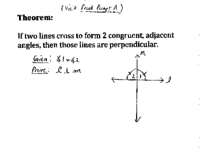
Proof Prompt (A)
[color=#0000ff][b]Theorem: [/b][/color][br][br]If two lines cross to form [color=#9900ff][b]congruent, adjacent angles[/b][/color], then those [b]lines are perpendicular.[/b] [br][br][br]Write a 2-column (or paragraph) proof that formally proves what this applet informally illustrates. [br][i][color=#cc0000]Be sure to set up an appropriate diagram, state what is given, and state what needs to be proven. [br]Then prove it! [/color][/i] [br][br]
Proof Prompt (A)
Area of a Triangle (Discovery)
[color=#000000]Interact with the applet below for a few minutes. [br][br][i]Be sure to move the [/i][b]VERTICES[/b] [i]of the triangle around each time [b]before you move the slider. [br][/b][/i][/color][br]Answer the questions that appear below the applet.
1
What LARGER FIGURE was formed when the slider reached its end? How do we know this to be true?
2.
How does the area of the original triangle compare with the area of this LARGER FIGURE?
3.
How do we find the area of this LARGER FIGURE? What is the formula we use to find it?
4.
Given your responses to (2) & (3), write a formula that gives the area of JUST ONE of these congruent triangles.
Quick (Silent) Demo
Parallelogram: Area
Directions:
In the app below, use the [b]filling[/b] slider to make the parallelogram light enough so that you can see the white gridlines through it. [b]But don't touch anything else yet! [/b][br][br]After you set the [b]filling[/b] slider, try to count the number of squares inside this parallelogram. [br]Be sure to include partial squares! Provide a good estimate in the question box below.
Try to count the number of squares inside this parallelogram. How many squares (i.e. square units) do you estimate to be inside this parallelogram?
Slide the "[b]Slide Me" [/b]slider now. Carefully observe what happens. What shape do you see now?
How does the area of this new shape compare with the area of the original parallelogram? How do you know this?
How many squares do you now count in the newer shape that was formed? How many squares were in the original parallelogram?
Without looking it up on another tab in your browser, describe how we can find the area of ANY PARALLELOGRAM.
Congruent Segments Construction (I)
I[color=#000000]n the applet below, use the limited toolbar to construct segments that are congruent to the two segments displayed.[br]Use the [b]Distance[/b] tool afterwards to show that these segments are indeed congruent. [/color]
I[color=#000000]n the applet below, use the limited toolbar to construct segments that are [b]triple the length[/b] of the two segments displayed.[br]Use the [b]Distance[/b] tool afterwards to show that these segments are indeed triple the length of the original segments displayed. [/color]
Equilateral Triangle Construction Template
[color=#000000]In the applet below, use the tools of the limited toolbar to construct an [b]equilateral triangle that's inscribed in the circle shown.[/b] [br][br][i]When you're finished, show that the triangle you've constructed is indeed an equilateral triangle.[/i][/color]
Geometry Resources
[list][*][b][url=https://www.geogebra.org/m/z8nvD94T]Congruence (Volume 1)[/url][/b][/*][*][b][url=https://www.geogebra.org/m/munhXmzx]Congruence (Volume 2)[/url][/b][/*][*][b][url=https://www.geogebra.org/m/dPqv8ACE]Similarity, Right Triangles, Trigonometry[/url][/b][/*][*][b][url=https://www.geogebra.org/m/C7dutQHh]Circles[/url][/b][/*][*][b][url=https://www.geogebra.org/m/K2YbdFk8]Coordinate and Analytic Geometry[/url][/b][/*][*][b][url=https://www.geogebra.org/m/xDNjSjEK]Area, Surface Area, Volume, 3D, Cross Section[/url] [/b][/*][*][b][url=https://www.geogebra.org/m/NjmEPs3t]Proof Challenges[/url] [/b][/*][/list]
